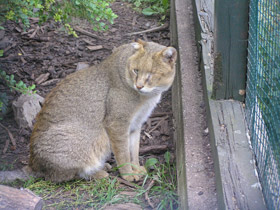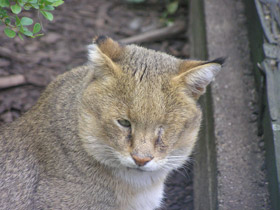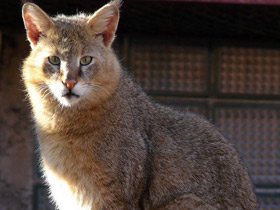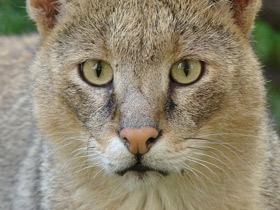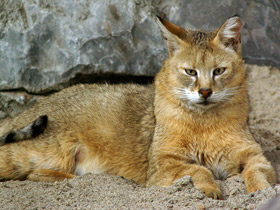The jungle cat, reed cat, swamp cat and jungle lynx (Felis chaus)
 The jungle cat, reed cat, swamp cat and jungle lynx (Felis chaus) is on the Russian Red List
The jungle cat, reed cat, swamp cat and jungle lynx (Felis chaus) is on the Russian Red List
The jungle cat (Felis chaus), also called reed cat, swamp cat and jungle lynx, is a medium-sized cat native to the Middle East, the Caucasus, South and Southeast Asia and southern China. It inhabits foremost wetlands like swamps, littoral and riparian areas with dense vegetation. It is listed as Least Concern on the IUCN Red List, and is mainly threatened by destruction of wetlands, trapping and poisoning.
The species was first described by Johann Anton Güldenstädt in 1776 based on a specimen caught in a Caucasian wetland. Johann Christian Daniel von Schreber gave the jungle cat its present binomial name and is therefore generally considered as binomial authority. Three subspecies are recognised at present.
Appearance
Felis chaus is a species of carnivorous mammal of the family Felidae.
The Felis chaus is larger than a domestic cat: it reaches a length of 60-90 cm and weighs between 8 and 12 kg. The body of the Felis chaus is relatively short and the slender tail is about 1/3 of the body length (21-30 cm). Externally, the Felis chaus differs considerably from forest or steppe cats: its legs are longer, its cheeks are malformed and its ears are large, triangular and erect, with small tassels on the tips.
Habitat
It occurs in a wide range of habitats, from West Asia, Asia Minor, Transcaucasia and Central Asia to Hindustan, Indochina and southwest China. Its main habitats are reedbeds, impassable thickets of thorny shrubs, dense, wet lowlands near lakes, river floodplains and sea shores; it avoids open steppe and deserts. As Felis chaus is poorly adapted to low temperatures, it does not climb high mountains; but sometimes settles near humans.
Nutrition and lifestyle
This animal is nocturnal or crepuscular, but can also hunt during the day. Felis chaus is an excellent hunter; it often ambushes, but can also ambush its prey near its den. Felis chaus feeds on rodents (mice, voles, gophers) and birds (ducks, coots, pheasants) that live near water; it sometimes hunts hares, young of small ungulates, reptiles (snakes, lizards, tortoises); it may attack domestic chickens, ducks and geese.
The Felis chaus is a cautious and reserved predator. It has excellent hearing: after hearing a flock of birds descending on the reeds, it approaches them silently and cautiously and, after leaping high up on its long legs, grabs its prey. The Felis chaus is not afraid of water and is a good climber, although not very frequent.
Behaviour and reproduction
Felis chaus lead a solitary life for most of the year. Each male has an individual territory, ranging in size from 45 to 180 km2, which partially overlaps with the territory of several females. During the breeding season, family groups consisting of a male, a female and their kittens can be found.
The female makes her den in very remote and secret places. She does not dig burrows, but uses abandoned burrows of other animals (badgers, porcupines, foxes), insulating them with dry grass and wool. Pregnancy lasts between 53 and 66 days and 2 to 5 blind kittens are born. Their eyes open after 10-12 days, and their mother feeds them with milk until they are 3 months old. The kittens grow quite rapidly and are fully independent by 5-6 months of age.
Young Felis chaus are very easy to tame and get used to humans. It is known that these predators were used to hunt waterfowl in ancient Egypt. An ancient Egyptian image has survived to the present day showing a tamed Felis chaus carrying its prey to its master.
Threats
Major threats to the jungle cat include habitat loss such as the destruction of wetlands, dam construction, environmental pollution, industrialisation and urbanisation. Illegal hunting is a threat in Turkey and Iran. Its rarity in Southeast Asia is possibly due to high levels of hunting. Since the 1960s, populations of the Caucasian jungle cat living along the Caspian Sea and in the Caucasus range states have been rapidly declining. Only small populations persist today. There has been no record in the Astrakhan Nature Reserve in the Volga Delta since the 1980s. It is rare in the Middle East. In Jordan, it is highly affected by the expansion of agricultural areas around the river beds of Yarmouk and Jordan rivers, where farmers hunted and poisoned jungle cats in retaliation for attacking poultry. It is also considered rare and threatened in Afghanistan. India exported jungle cat skins in large numbers, until this trade was banned in 1979; some illegal trade continues in the country, in Egypt and Afghanistan.
In the 1970s, Southeast Asian jungle cats still used to be the most common wild cats near villages in certain parts of northern Thailand and occurred in many protected areas of the country. However, since the early 1990s, jungle cats are rarely encountered and have suffered drastic declines due to hunting and habitat destruction. Today, their official status in the country is critically endangered. In Cambodia, Laos and Vietnam, jungle cats have been subject to extensive hunting. Skins are occasionally recorded in border markets, and live individuals, possibly taken from Myanmar or Cambodia, occasionally turn up in the Khao Khieo and Chiang Mai zoos of Thailand.
Conservation
The jungle cat is listed under CITES Appendix II. Hunting is prohibited in Bangladesh, China, India, Israel, Myanmar, Pakistan, Tajikistan, Thailand and Turkey. But it does not receive legal protection outside protected areas in Bhutan, Georgia, Laos, Lebanon, Nepal, Sri Lanka and Vietnam.
Subspecies
The following subspecies are recognised:
- Felis chaus chaus: Caucasus, Turkestan, Iran, Baluchistan, Jakarta and Chinese Turkestan.
- Felis chaus affinis: inhabits the Himalayan region from Kashmir and Nepal to Sikkim and Yunnan.
- Felis chaus fulvidina: Southeast Asia, as far as Burma, Laos, Thailand, Cambodia and Vietnam.
- Felis chaus furax: inhabits Palestine, Syria and Iraq.
- Felis chaus kelaarti: Sri Lanka and south-east India.
- Felis chaus kutas: Bengal to Kutch.
- Felis chaus maimanah: Northern Afghanistan.
- Felis chaus nilotica: Egyptian.
- Felis chaus oxiana: all over India.
- Felis chaus prateri: India and Sind.

















